Dubose Tree Service, Inc.
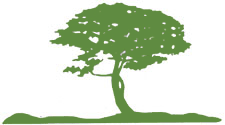
707.964.3599 / 707.489.9770
Member of these associations

Pruning & Health
Pruning Young Trees | Pruning Mature Trees | Avoiding Tree Damage During Construction
Why Topping Hurts Trees | Pest Management (PDF)
Pruning Young Trees
Proper pruning is essential in developing a tree with a strong structure and desirable form. Trees that receive the appropriate pruning measures while they are young will require little corrective pruning when they mature.
Keep these few simple principles in mind before pruning a tree:
- Each cut has the potential to change the growth of the tree. Always have a purpose in mind before making a cut.
- Proper technique is essential. Poor pruning can cause damage that lasts for the life of the tree. Learn where and how to make the cuts before picking up the pruning shears.
- Trees do not heal the way people do. When a tree is wounded, it must grow over and compartmentalize the wound. As a result, the wound is contained within the tree forever.
- Small cuts do less damage to the tree than large cuts. For that reason, proper pruning (training) of young trees is critical. Waiting to prune a tree until it is mature can create the need for large cuts that the tree cannot easily close.
Making The Cut
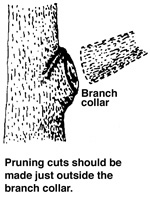
Where you make a pruning cut is critical to a tree's response in growth and wound closure. Make pruning cuts just outside the branch collar. Because the branch collar contains trunk or parent branch tissues, the tree will be damaged unnecessarily if you remove or damage it. In fact, if the cut is large, the tree may suffer permanent internal decay from an improper pruning cut.
If a permanent branch is to be shortened, cut it back to a lateral branch or bud. Internodal cuts, or cuts made between buds or branches, may lead to stem decay, sprout production, and misdirected growth.
Pruning Tools
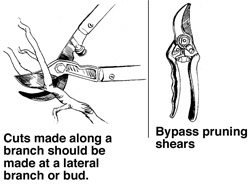
When pruning trees, it is important to have the right tool for the job. For small trees, most cuts can be made with hand pruners, we prefer felco #30's in the shore and bishop pines. Although bypass pruners should be used in trees with more sensitive bark to avoid tearing the collar. For example fruit trees and ornamental maples.
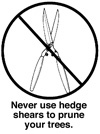
Never use hedge shears to prune a tree. Whatever tool you use, make sure it is kept clean and sharp.
Establishing a Strong Scaffold Structure
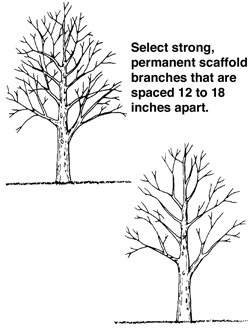
A good structure of primary scaffold branches should be established while the tree is young. The scaffold branches provide the framework of the mature tree. Properly trained young trees will develop a strong structure that requires less corrective pruning as they mature.
The goal in training young trees is to establish a strong trunk with sturdy, well-spaced branches. The strength of the branch structure depends on the relative sizes of the branches, the branch angles, and the spacing of the limbs. Naturally, those factors vary with the growth habit of the tree. Douglas Fir and Redwoods, for example, have a conical shape with a central leader. Monterey Pines and Blue Gum Eucalyptus are often wide-spreading without a central leader. Good pruning techniques remove structurally weak branches while maintaining the natural form of the tree.
Trunk Development
For most young trees, maintain a single dominant leader. Do not prune back the tip of this leader. Do not allow secondary branches to outgrow the leader. Sometimes a tree will develop double leaders known as co-dominant stems. Co-dominant stems can lead to structural weaknesses, so it is best to remove one of the stems while the tree is young.
The lateral branches contribute to the development of a sturdy well-tapered trunk. It is important to leave some of these lateral branches in place, even though they may be pruned out later. These branches, known as temporary branches, also help protect the trunk from sun and mechanical injury. Temporary branches should be kept short enough not to be an obstruction or compete with selected permanent branches.
Permanent Branch Selection
Nursery trees often have low branches that may make the tree appear well-proportioned when young, but low branches are seldom appropriate for large-growing trees in an urban environment. How a young tree is trained depends on its primary function in the landscape. For example, street trees must be pruned so that they allow at least 16 feet of clearance for traffic. Most landscape trees require only about 8 feet of clearance.
The height of the lowest permanent branch is determined by the tree's intended function and location in the landscape. Trees that are used to screen an unsightly view or provide a wind break may be allowed to branch low to the ground. Most large-growing trees in the landscape must eventually be pruned to allow head clearance.
The spacing of branches, both vertically and radially, in the tree is very important. Branches selected as permanent scaffold branches must be well-spaced along the trunk. Maintain radial balance with branches growing outward in each direction.
A good rule of thumb for the vertical spacing of permanent branches is to maintain a distance equal to 3 percent of the tree's eventual height. Thus, a tree that will be 50 feet tall should have permanent scaffold branches spaced about 18 inches apart along the trunk. Avoid allowing two scaffold branches to arise one above the other on the same side of the tree.
Some trees have a tendency to develop branches with narrow angles of attachment and tight crotches. As the tree grows, bark can become enclosed deep within the crotch between the branch and the trunk. Such growth is called included bark. Included bark weakens the attachment of the branch to the trunk and can lead to branch failure when the tree matures. You should prune branches with weak attachments while they are young.
Avoid overthinning the interior of the tree. The leaves of each branch must manufacture enough food to keep that branch alive and growing. In addition, each branch must contribute food to grow and feed the trunk and roots. Removal of too many leaves can "starve" the tree, reduce growth, and make the tree unhealthy. A good rule of thumb is to maintain at least half the foliage on branches arising in the lower two-thirds of the tree.
Newly Planted Trees
Pruning of newly planted trees should be limited to corrective pruning. Remove torn or broken branches, and save other pruning measures for the second or third year.
The belief that trees should be pruned when planted to compensate for root loss is misguided. Trees need their leaves and shoot tips to provide food and the substances that stimulate new root production. Unpruned trees establish faster with a stronger root system than trees pruned at the time of planting.
Wound Dressings
Wound dressings were once thought to accelerate wound closure, protect against insects and diseases, and reduce decay.
However, research has shown that dressings do not reduce decay or speed closure and rarely prevent insect or disease infestations. Most experts recommend that wound dressing not be used. If a dressing must be used for cosmetic purposes, use a thin coating of a material that is not toxic to the plant.
Pruning Mature Trees
Pruning is the most common tree maintenance procedure. Although forest trees grow quite well with only nature's pruning, landscape trees require a higher level of care to maintain their safety and aesthetics. Pruning should be done with an understanding of how the tree responds to each cut. Improper pruning can cause damage that will last for the life of the tree, or worse, shorten the tree's life.
Reasons for Pruning
Because each cut has the potential to change the growth of the tree, no branch should be removed without a reason. Common reasons for pruning are to remove dead branches, to remove crowded or rubbing limbs, and to eliminate hazards. Trees may also be pruned to increase light and air penetration to the inside of the tree's crown or to the landscape below. In most cases, mature trees are pruned as a corrective or preventive measure.
Routine thinning does not necessarily improve the health of a tree. Trees produce a dense crown of leaves to manufacture the sugar used as energy for growth and development. Removal of foliage through pruning can reduce growth and stored energy reserves. Heavy pruning can be a significant health stress for the tree.
Yet if people and trees are to coexist in an urban or suburban environment, then we sometimes have to modify the trees. City environments do not mimic natural forest conditions. Safety is a major concern. Also, we want trees to complement other landscape plantings and lawns. Proper pruning, with an understanding of tree biology, can maintain good tree health and structure while enhancing the aesthetic and economic values of our landscapes.
When to Prune
Most routine pruning to remove weak, diseased, or dead limbs can be accomplished at any time during the year with little effect on the tree. As a rule, growth is maximized and wound closure is fastest if pruning takes place before the spring growth flush. Some trees, such as maples and birches, tend to "bleed" if pruned early in the spring. It may be unsightly, but it is of little consequence to the tree.
A few tree diseases, such as oak wilt, can be spread when pruning wounds allow spores access into the tree. Susceptible trees should not be pruned during active transmission periods.
Heavy pruning just after the spring growth flush should be avoided. At that time, trees have just expended a great deal of energy to produce foliage and early shoot growth. Removal of a large percentage of foliage at that time can stress the tree.
Making Proper Pruning Cuts
Pruning cuts should be made just outside the branch collar. The branch collar contains trunk or parent branch tissue and should not be damaged or removed. If the trunk collar has grown out on a dead limb to be removed, make the cut just beyond the collar. Do not cut the collar.
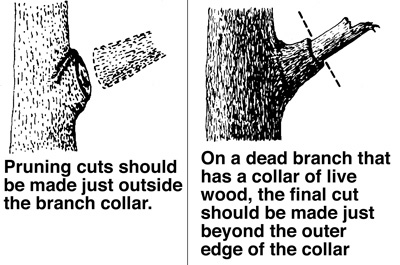
If a large limb is to be removed, its weight should first be reduced. This is done by making an undercut about 12 to 18 inches from the limb's point of attachment. Make a second cut from the top, directly above or a few inches farther out on the limb. Doing so removes the limb, leaving the 12- to 18-inch stub. Remove the stub by cutting back to the branch collar. This technique reduces the possibility of tearing the bark.

Pruning Techniques
Specific types of pruning may be necessary to maintain a mature tree in a healthy, safe, and attractive condition.
Cleaning is the removal of dead, dying, diseased, crowded, weakly attached, and low-vigor branches from the crown of a tree.
Thinning is the selective removal of branches to increase light penetration and air movement through the crown. Thinning opens the foliage of a tree, reduces weight on heavy limbs, and helps retain the tree's natural shape.
Raising removes the lower branches from a tree in order to provide clearance for buildings, vehicles, pedestrians, and vistas.
Reduction reduces the size of a tree, often for clearance for utility lines. Reducing the height or spread of a tree is best accomplished by pruning back the leaders and branch terminals to lateral branches that are large enough to assume the terminal roles (at least one-third the diameter of the cut stem). Compared to topping, reduction helps maintain the form and structural integrity of the tree.
How Much Should Be Pruned?
The amount of live tissue that should be removed depends on the tree size, species, and age, as well as the pruning objectives. Younger trees tolerate the removal of a higher percentage of living tissue better than mature trees do. An important principle to remember is that a tree can recover from several small pruning wounds faster than from one large wound.
A common mistake is to remove too much inner foliage and small branches. It is important to maintain an even distribution of foliage along large limbs and in the lower portion of the crown. Overthinning reduces the tree's sugar production capacity and can create tip-heavy limbs that are prone to failure.
Mature trees should require little routine pruning. A widely accepted rule of thumb is never to remove more than one-quarter of a tree's leaf-bearing crown. In a mature tree, pruning even that much could have negative effects. Removing even a single, large-diameter limb can create a wound that the tree may not be able to close. The older and larger a tree becomes, the less energy it has in reserve to close wounds and defend against decay or insect attack. The pruning of large mature trees is usually limited to removal of dead or potentially hazardous limbs.
Wound Dressings
Wound dressings were once thought to accelerate wound closure, protect against insects and diseases, and reduce decay. However, research has shown that dressings do not reduce decay or speed closure and rarely prevent insect or disease infestations. Most experts recommend that wound dressings not be used. If a dressing must be used for cosmetic purposes, then only a thin coating of a nontoxic material should be applied.
Hiring an Arborist
Pruning large trees can be dangerous. If pruning involves working above the ground or using power equipment, it is best to hire a professional arborist. An arborist can determine the type of pruning necessary to improve the health, appearance, and safety of your trees. A professional arborist can provide the services of a trained crew, with all of the required safety equipment and liability insurance.

There are a variety of things to look for when selecting an arborist:
- membership in professional organizations such as the International Society of Arboriculture (ISA), the Tree Care Industry Association (TCIA), or the American Society of Consulting Arborists (ASCA)
- certification through ISA's Certified Arborist program
- proof of insurance
- list of references (don't hesitate to check)
Avoid using the services of any tree company that
- advertises topping as a service provided; knowledgeable arborists know that topping is harmful to trees and is not an accepted practice
- uses tree climbing spikes to climb trees that are being pruned; climbing spikes can damage trees, and their use should be limited to trees that are being removed
Avoiding Tree Damage During Construction
As cities and suburbs expand, wooded lands are being developed into commercial and residential sites. Homes are constructed in the midst of trees to take advantage of the aesthetic and environmental value of the wooded lots. Wooded properties can be worth as much as 20 percent more than those without trees, and people value the opportunity to live among trees.
Unfortunately, the processes involved with construction can be deadly to nearby trees. Unless the damage is extreme, the trees may not die immediately but could decline over several years. With this delay in symptom development, you may not associate the loss of the tree with the construction.
It is possible to preserve trees on building sites if the right measures are taken. The most important step is to hire a professional arborist during the planning stage. An arborist can help you decide which trees can be saved and can work with the builder to protect the trees throughout each construction phase.
How Trees Are Damaged During Construction
Physical Injury to Trunk and Crown. Construction equipment can injure the aboveground portion of a tree by breaking branches, tearing the bark, and wounding the trunk. These injuries are permanent and, if extensive, can be fatal.
Cutting of Roots. The digging and trenching that are necessary to construct a house and install underground utilities will likely sever a portion of the roots of many trees in the area. It is easy to appreciate the potential for damage if you understand where roots grow. The roots of a tree are found mostly in the upper 6 to 12 inches of the soil. In a mature tree, the roots extend far from the trunk. In fact, roots typically are found growing a distance of one to three times the height of the tree. The amount of damage a tree can suffer from root loss depends, in part, on how close to the tree the cut is made. Severing one major root can cause the loss of 5 to 20 percent of the root system.
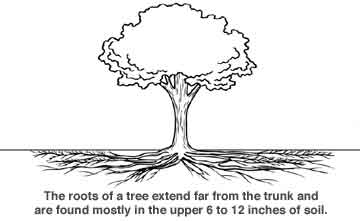
Another problem that may result from root loss caused by digging and trenching is that the potential for the trees to fall over is increased. The roots play a critical role in anchoring a tree. If the major support roots are cut on one side of a tree, the tree may fall or blow over.

Less damage is done to tree roots if utilities are tunneled under a tree rather than across the roots.
Soil Compaction. An ideal soil for root growth and development is about 50 percent pore space. These pores—the spaces between soil particles—are filled with water and air. The heavy equipment used in construction com-pacts the soil and can dramatically reduce the amount of pore space. This compaction not only inhibits root growth and penetration but also decreases oxygen in the soil that is essential to the growth and function of the roots.
Smothering Roots by Adding Soil. Most people are surprised to learn that 90 percent of the fine roots that absorb water and minerals are in the upper 6 to 12 inches of soil. Roots require space, air, and water. Roots grow best where these requirements are met, which is usually near the soil surface. Piling soil over the root system or increasing the grade smothers the roots. It takes only a few inches of added soil to kill a sensitive mature tree.
Exposure to the Elements. Trees in a forest grow as a community, protecting each other from the elements. The trees grow tall, with long, straight trunks and high canopies. Removing neighboring trees or opening the shared canopies of trees during construction exposes the remaining trees to sunlight and wind. The higher levels of sunlight may cause sunscald on the trunks and branches. Also, the remaining trees are more prone to breaking from wind.
Getting Advice
Hire a professional arborist in the early planning stage. Many of the trees on your property may be saved if the proper steps are taken. Allow the arborist to meet with you and your building contractor. Your arborist can assess the trees on your property, determine which are healthy and structurally sound, and suggest measures to preserve and protect them.
One of the first decisions is determining which trees are to be preserved and which should be removed. You must consider the species, size, maturity, location, and condition of each tree. The largest, most mature trees are not always the best choices to preserve. Younger, more vigorous trees usually can survive and adapt to the stresses of construction better. Try to maintain diversity of species and ages. Your arborist can advise you about which trees are more sensitive to compaction, grade changes, and root damage.
Planning
Your arborist and builder should work together in planning the construction. The builder may need to be educated regarding the value of the trees on your property and the importance of saving them. Few builders are aware of the way trees' roots grow and what must be done to protect them.
Sometimes small changes in the placement or design of your house can make a great difference in whether a critical tree will survive. An alternative plan may be more friendly to the root system. For example, bridging over the roots may substitute for a conventional walkway. Because trenching near a tree for utility installation can be damaging, tunneling under the root system may be a good option.
Erecting Barriers
Because our ability to repair construction damage to trees is limited, it is vital that trees be protected from injury. The single most important action you can take is to set up construction fences around all of the trees that are to remain. The fences should be placed as far out from the trunks of the trees as possible. As a general guideline, allow 1 foot of space from the trunk for each inch of trunk diameter. The intent is not merely to protect the aboveground portions of the trees but also the root systems. Remember that the root systems extend much farther than the drip lines of the trees.
Instruct construction personnel to keep the fenced area clear of building materials, waste, and excess soil. No digging, trenching, or other soil disturbance should be allowed in the fenced area.
Protective fences should be erected as far out from the trunks as possible in order to protect the root system.
Limiting Access
If at all possible, it is best to allow only one access route on and off the property. All contractors must be instructed where they are permitted to drive and park their vehicles. Often this same access drive can later serve as the route for utility wires, water lines, or the driveway.
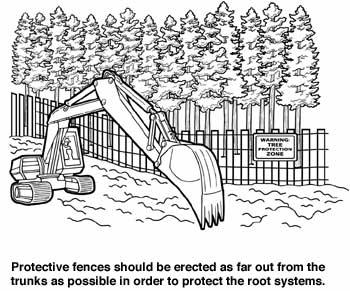
Specify storage areas for equipment, soil, and construction materials. Limit areas for burning (if permitted), cement wash-out pits, and construction work zones. These areas should be away from protected trees.
Maintaining Good Communications
It is important to work together as a team. You may share clear objectives with your arborist and your builder, but one subcontractor can destroy your prudent efforts. Construction damage to trees is often irreversible. Friendly reminders go a long way.
Final Stages
It is not unusual to go to great lengths to preserve trees during construction, only to have them injured during landscaping. Installing irrigation systems and rototilling planting beds are two ways the root systems of trees can be damaged. Remember also that small increases in grade (as little as 2 to 6 inches) that place additional soil over the roots can be devastating to your trees. Careful planning and communicating with landscape designers and contractors is just as important as avoiding tree damage during construction.
Post-Construction Tree Maintenance
Your trees will require several years to adjust to the injury and environmental changes that occur during construction. Stressed trees are more prone to health problems such as disease and insect infestations. Talk to your arborist about continued maintenance for your trees. Continue to monitor your trees, and have them periodically evaluated for declining health or safety hazards.
Despite the best intentions and most stringent tree preservation measures, your trees still might be injured from the construction process. Your arborist can suggest remedial treatments to help reduce stress and improve the growing conditions around your trees.
Why Topping Hurts Trees
Topping is perhaps the most harmful tree pruning practice known. Yet, despite more than 25 years of literature and seminars explaining its harmful effects, topping remains a common practice. This brochure explains why topping is not an acceptable pruning technique and offers better alternatives.
What is Topping?

Topping is the indiscriminate cutting of tree branches to stubs or lateral branches that are not large enough to assume the terminal role.
The most common reason given for topping is to reduce the size of a tree. Home owners often feel that their trees have become too large for their property. People fear that tall trees may pose a hazard. Topping, however, is not a viable method of height reduction and certainly does not reduce the hazard. In fact, topping will make a tree more hazardous in the long term.
Topping Stresses Trees
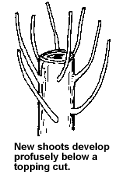
Topping often removes 50 to 100 percent of the leaf-bearing crown of a tree. Because leaves are the food factories of a tree, removing them can temporarily starve a tree. The severity of the pruning triggers a sort of survival mechanism. The tree activates latent buds, forcing the rapid growth of multiple shoots below each cut. The tree needs to put out a new crop of leaves as soon as possible. If a tree does not have the stored energy reserves to do so, it will be seriously weakened and may die.
A stressed tree is more vulnerable to insect and disease infestations. Large, open pruning wounds expose the sapwood and heartwood to attacks. The tree may lack sufficient energy to chemically defend the wounds against invasion, and some insects are actually attracted to the chemical signals trees release. Although Redwood trees appear more tolerant to severe pruning, it is only in the appearance, the wood where cut will decay and new growth will become weakly attached. Other trees like Monterey, Bishop or Shore Pines are more likely to show signs of the damage in a more visual way.
Topping Causes Decay
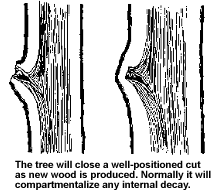
The preferred location to make a pruning cut is just beyond the branch collar at the branch's point of attachment. The tree is biologically equipped to close such a wound, provided the tree is healthy enough and the wound is not too large. Cuts made along a limb between lateral branches create stubs with wounds that the tree may not be able to close. The exposed wood tissues begin to decay. Normally, a tree will "wall off," or compartmentalize, the decaying tissues, but few trees can defend the multiple severe wounds caused by topping. The decay organisms are given a free path to move down through the branches.
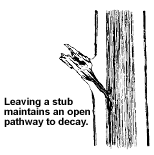
Topping Can Lead to Sunburn
Branches within a tree's crown produce thousands of leaves to absorb sunlight. When the leaves are removed, the remaining branches and trunk are suddenly exposed to high levels of light and heat. The result may be sunburn of the tissues beneath the bark, which can lead to cankers, bark splitting, and death of some branches.
Topping Creates Hazards
The survival mechanism that causes a tree to produce multiple shoots below each topping cut comes at great expense to the tree. These shoots develop from buds near the surface of the old branches. Unlike normal branches that develop in a socket of overlapping wood tissues, these new shoots are anchored only in the outermost layers of the parent branches.
The new shoots grow quickly, as much as 20 feet in one year, in some species. Unfortunately, the shoots are prone to breaking, especially during windy conditions. The irony is that while the goal was to reduce the tree's height to make it safer, it has been made more hazardous than before.
Topping Makes Trees Ugly
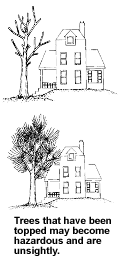
The natural branching structure of a tree is a biological wonder. Trees form a variety of shapes and growth habits, all with the same goal of presenting their leaves to the sun. Topping removes the ends of the branches, often leaving ugly stubs. Topping destroys the natural form of a tree.
Without leaves (up to 6 months of the year in temperate climates), a topped tree appears disfigured and mutilated. With leaves, it is a dense ball of foliage, lacking its simple grace. A tree that has been topped can never fully regain its natural form.
Alternatives to Topping
Sometimes a tree must be reduced in height or spread. Providing clearance for utility lines is an example. There are recommended techniques for doing so. If practical, branches should be removed back to their point of origin. If a branch must be shortened, it should be cut back to a lateral that is large enough to assume the terminal role. A rule of thumb is to cut back to a lateral that is at least one-third the diameter of the limb being removed.
This method of branch reduction helps to preserve the natural form of the tree. However, if large cuts are involved, the tree may not be able to close over and compartmentalize the wounds. Sometimes the best solution is to remove the tree and replace it with a species that is more appropriate for the site.
Hiring an Arborist
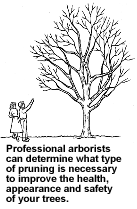
Pruning large trees can be dangerous. If pruning involves working above the ground or using power equipment, it is best to hire a professional arborist. An arborist can determine the type of pruning that is necessary to improve the health, appearance, and safety of your trees. A professional arborist can provide the services of a trained crew, with all of the required safety equipment and liability insurance.
When selecting an arborist :
- check for membership in professional organizations such as the International Society of Arboriculture (ISA), the Tree Care Industry Association (TCIA), or the American Society of Consulting Arborists (ASCA). Such membership demonstrates a willingness on the part of the arborist to stay up to date on the latest techniques and information.
- ask for proof of insurance.
- ask for a list of references, and don't hesitate to check them.
- avoid using the services of any tree company that
- advertises topping as a service provided. Knowledgeable arborists know that topping is harmful to trees and is not an accepted practice.
- uses tree climbing spikes to climb trees that are being pruned. Climbing spikes can damage trees, and their use should be limited to trees that are being removed.